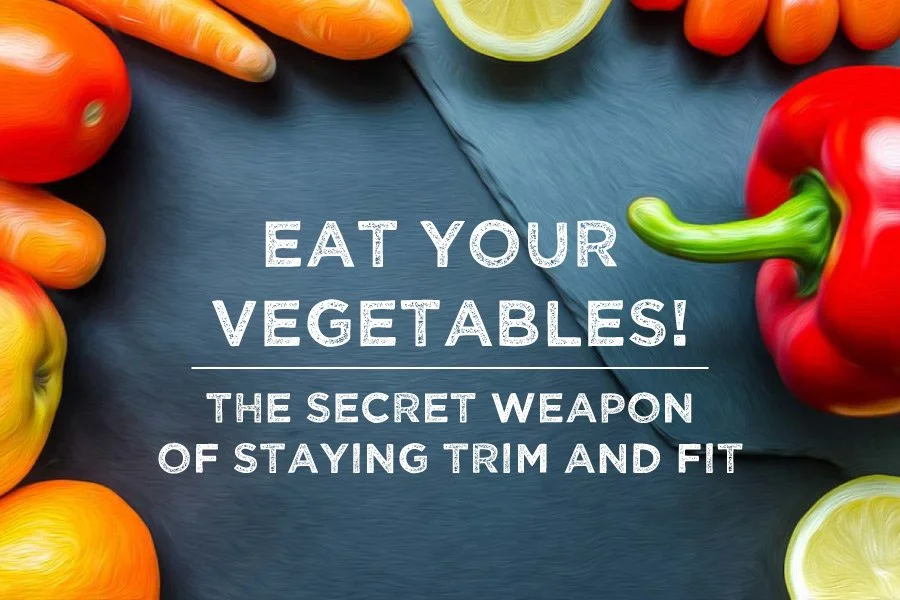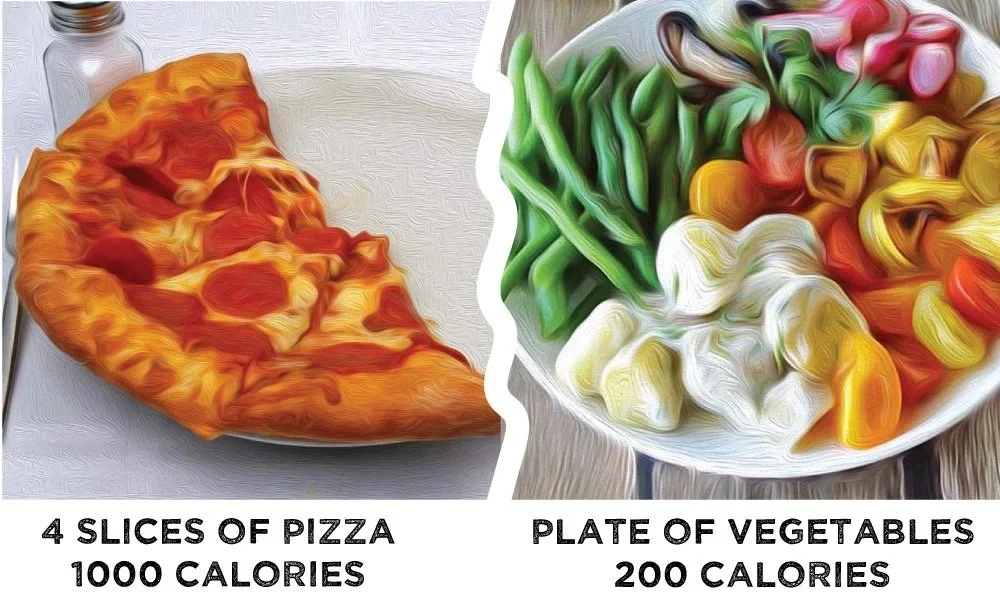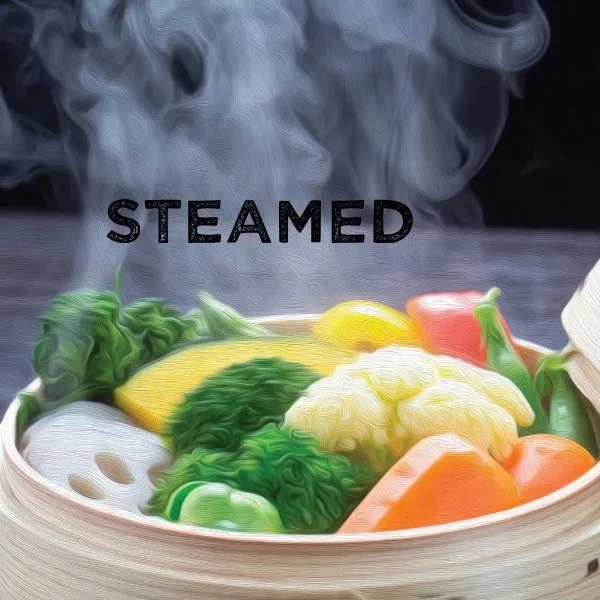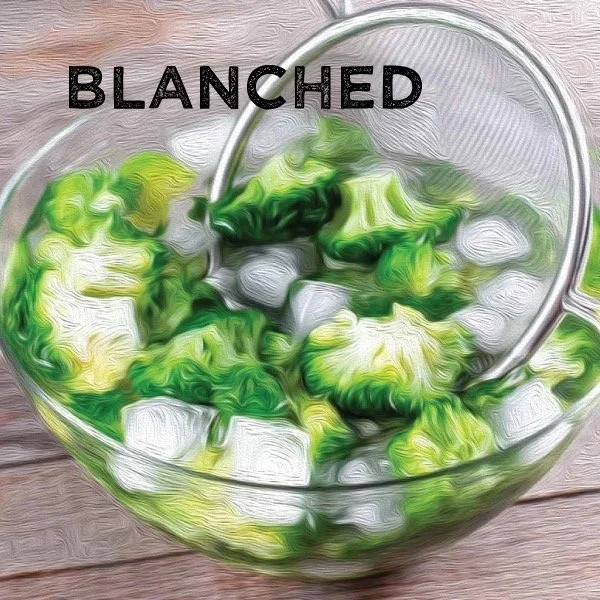Eat Your Vegetables!
Something we often say at Kenzai is that healthy, fit people don’t eat salads. They eat vegetables. Vegetables are the cornerstone of a nutritious diet that makes you feel good in your body and look good in the mirror.
The magic of vegetables isn’t just about the vitamins and minerals they contain. It’s something much simpler. So simple it’s easy to overlook.
People really like to eat food. They like to enjoy a variety of flavors and textures, and they like to feel full. Vegetables make it possible to have all of these things without taking on a high caloric load which will show up later in body fat.
Take a look at these two plates. Both plates are full of warm tasty food. Both plates will fill the stomach and have you leaning back from the table feeling satisfied. But there's one big difference — the caloric density.
When you eat those slices of pepperoni pizza, you’re onboarding carbohydrates (crust), lipids (cheese, oil, pepperoni fat) and protein (beef and pork from the pepperoni). There’s nothing wrong with these macronutrients in general, but in this meal they're extremely over-represented and pack a lot of energy into your body. That energy will have to be dealt with, either through a big dose of exercise, (1000 calories = 1 hour of hard jogging) or as newly formed adipose cells in your fat storage.
The plate of vegetables, on the other hand, doesn’t fill you with carbs, fat, and protein. 80-90% of vegetable mass is 0-calorie water. It fills the stomach briefly (enough to make you feel full) and then quickly exits the system via your urine. One of the things you notice when you’re eating a lot of vegetables is that you’re having to go to the bathroom frequently, just as if you were drinking bottles of water all day. In a sense, you are, you’re just eating your water instead of drinking it!
The remainder 10-20% of vegetable mass is a mixture of 0-calorie fiber and a miniscule amount of carbs, fat, and protein. This is how a full, steaming plate of delicious vegetables can be just 1/5th the caloric load of a richer, junkier food.
If you go out of your way to eat vegetables, not just as a side dish but as the majority of food on your plate, something magical happens. You don’t feel a strong desire to overeat or partake in rich food, because of the simple fact that you’re full and satiated.
You can try this experiment for yourself anytime. Eat a whole head of broccoli, or a plate of asparagus, or an entire bunch of carrots, or a big bowl full of Brussel’s sprouts, and see how unappetizing any kind of food is after that much water and fiber is in your system. And yet each of these massive vegetable servings are less than 100 Calories. You’re stuffed, but stuffed with stuff that doesn’t make you fat, but fit!
Most people can understand the logic of this, but still don’t take the final step of including bountiful amounts of vegetables in their diet. The reason is understandable -— preparing and eating vegetables feels like a chore. In this article we aim to change that attitude and get more vegetables on your plate.
Making a Mental Shift
Before we get into the details of what to do in the kitchen, let’s get our heads screwed on right. We’re not going to pretend that preparing a fresh, healthy plate of vegetables is as fast or easy as opening up a bag of potato chips or getting take-out. Vegetables do take more planning and time commitment, but put this commitment into perspective. This is time spent on your health and fitness. Nothing else in your life will go well if YOU aren’t well. Health is the bedrock of all your dreams and aspirations.
Let’s say that all this vegetable prep and cooking takes an extra two hours a week (15 minutes a day). That’s two hours a week going towards your nutrition, which is your most basic, fundamental health practice. Is that not a good use of two hours a week? The truth is when you’ve got vegetables as part of every meal, not only will you look and feel better, you’ll start getting those two hours back in the form of more energy, focus, and less time needed to exercise-off excess caloric load.
Try to get in the mindset of vegetable prep as an unskippable daily hygiene practice, just like brushing, flossing, and bathing. It’s a hugely effective use of your fitness time. Two hours of vegetable prep will get more results than two hours of exercise.
That being said, there are things you can do to streamline the prep process and add variety so that eating your vegetables doesn’t feel like such a chore.
Gear Up
If you’re going to have more vegetables in your life, it’s worth investing in the tools of the trade. These are:
A good set of knives in various sizes to handle the different shapes that vegetables come in. You can give yourself even more options with a mandoline slicer which makes quick work of any cutting task.
A good cutting board which doesn’t slip or warp with use. Avoid glass cutting boards which dull your knives quickly.
A good peeler that lets you quickly strip down vegetables safely.
A selection of quality cookware that isn’t too hard to clean.
A selection of pans for oven work.
A good selection of containers that keep prepared vegetables fresh for a few days. Especially useful are containers with an internal basket that allows some drainage to prevent rot.
Batch Prep
You can win back a lot of your time by chopping and cooking a big batch of vegetables at once. It takes just slightly longer to cook five vegetable servings as it takes to cook one. Plan ahead and make things in batches to use throughout the week. This will greatly help you in the goal of eating vegetables not just as random sides but as the centerpiece of every meal.
Vegetable Prep Techniques - Which have you not tried in a while?
People tend to get stuck in a rut and repeat the same vegetable prep method again and again. Let's remind ourselves of the dozens of ways vegetables can be presented and freshen up those healthy plates.
Of course you always have the option to eat your vegetables raw. The problem with raw vegetables is that it tends to restrict your choices to the classics (carrots, celery, cucumber, cherry tomatoes, lettuce, maybe broccoli and cauliflower). Often these raw vegetables are served with heavy dips or dressings which obliterate their low-calorie advantage.
In many cases, proper cooking will actually enhance the nutritional value of your vegetable, as the heat breaks the food down into more bioavailable molecular structures that the body can make better use of. Raw food is great, but it’s not the holy grail that it’s made out to be in some faddish food circles.
Pickling is the process of submerging a food in a salty brine or vinegar solution. This lowers the pH of the system to under 4.5, which makes it difficult for bacteria to grow, promoting long storage life. For vegetables, the pickling process creates unique colors, textures, and tastes, as the plant cells undergo anaerobic fermentation and reveal new dimensions. Think beyond boring old dill pickles. There's a world of flavors out there — sauerkraut, kimchi, pickled onions, bell-peppers, beets, daikon...the possibilities are endless.
Pickling is an invigorating way to eat more raw vegetables without feeling like a rabbit. A good pickled vegetable will bring an acidic pop to any meal. The only downside is the high amount of sodium in pickled food, so use pickles judiciously, thinking of them almost as a spice rather than a significant portion of the plate.
Adding the Heat - Let's Get Cooking!
There’s a hierarchy within the world of cooking vegetables. The more elaborate your cooking gets, the more likely nutrients are lost and phantom calories are added on. The following list of cooking methods will go from the cleanest, most nutritious methods to the least healthy methods. You should feel free to use any and all of the cooking techniques below. The key is that you’re eating vegetables in large amounts, at every meal (including breakfast)! Don’t demotivate yourself by thinking your life is nothing but raw carrots every day.
Steaming is essentially cooking something with moist, superheated air (steam is much hotter than boiling water). It works especially well with vegetables because the steam softens up the fiber and cellular structure of the plant, while keeping color, texture, and taste intact. The key is to not oversteam, which will break the cellular structures and deliver a limp, tasteless mush.
The secret to good steaming is not mixing your vegetable types. For example, broccoli will steam faster than sweet potato, so you’d want to steam those two things separately. A multi-level steamer basket makes this possible without needing to reset everything each time. Put your longer steam-time items on the bottom and the shorter timed items on the top.
You can also steam vegetables in the microwave. Place the vegetables in a microwave safe bowl, cover with plastic wrap or a lid, and heat for 2 minutes. Take them out, check for doneness, and put back in if more cooking is needed.
You know your vegetables are properly steamed when they show just a bit of resistance to a knife tip poked into them.
Steamed vegetables taste fantastic with a bit of salt, fresh herbs, or lemon on top. If you’ve had a bad experience with mushy, tasteless steamed vegetables in the past, give it another try!
After steaming, blanching is the next most nutritional way to prepare vegetables. To blanch, bring a pot of water to a rolling boil and drop in a single type of vegetable (like steaming, don’t mix vegetables). After a few minutes remove the vegetables and put them directly in an ice bath. This immediately stops the cooking process and creates crisp, bright vegetables.
When you want a nice “snap” to your vegetables without the raw taste, blanching is a great choice. It’s also the best way to prepare vegetables for freezing.
Boiled vegetables have gained a bad reputation as the cooking choice for people who don’t know how to cook. But boiling done right creates tender, tasty vegetables which can be integrated into many dishes.
People’s biggest mistake is boiling too long and too hard. Too long of a boil takes all texture away from the vegetable, while letting nutrients leech out into the water. Cooking too hard (at a constant vigorous boil) breaks up the vegetable into unpleasantly small pieces.
To boil correctly, cut the vegetable into small, uniform pieces. If your pieces are too large the outside will be done while the inside is raw. Try not to boil anything thicker than the width of your thumb. Don’t leave the vegetables in for more than 5-7 minutes, and turn the heat down to a simmer so that the food isn’t being battered by the hot rising bubbles.
Boiling is a useful technique when you want to blend or mash your vegetables, and is great for children’s dishes. Kids will often do better with something like a dollop of seasoned mashed broccoli than pieces of intact broccoli. While you do lose some nutrients to the boiling process, that shouldn’t stop you from boiling when a recipe calls for it. Even with slightly lower nutrition, a boiled vegetable has a lot more nutrients and fiber than no vegetables at all!
Pressure-cooking / Instant Pot
A pressure cooker is kind of boiling and steaming on steroids. The internal pressure of the pot is raised, creating super hot boiling water and steam. This cooks vegetables very quickly, (just 3 minutes is usually enough) but does leech nutrients out as cell walls collapse under the pressure. Pressure cooking is great when you want to create moisture and softness in your vegetables, or when you're making soups and stews.
Roasting, broiling, and air-frying; these three methods are all variations on the same idea -— you’re using hot, dry air to cook the vegetables at a much higher temperature than methods that use water. Because of the higher temperatures, wonderful reactions happen in the vegetables that lead to caramelization and a trace of char. This gives the food complexity and depth.
Most vegetables cook best around 400°F (200°C). Broiling adds this heat from above and creates more char. Roasting has the heat coming from all sides of the oven. An air-fryer forces the heat around and through the food with a fan, creating a crispier texture.
The problem with these methods is that the vegetables need a medium to transmit the heat from the air to the dry surface of the food. This is where cooking oil comes in, as its lipid structures are able to stay intact at high heat and cook the food that they coat. With every teaspoon of cooking oil used to broil, roast, or air-fry, you’re adding caloric load to the food. This is true whether the oil has a healthy glow about it (olive oil and avocado oil come to mind) or are the less glorified versions, canola, soybean, sunflower, and sesame oil. Calorically, they’re all the same.
There are a few things you can do to minimize the phantom calories that come from cooking oils:
Use a spray can or pump operated oil dispenser. This lets you coat the vegetables with just a fraction of the oil needed when pouring from a bottle.
Cook your vegetables on a rack so that oil can drip to the bottom and stay off your plate.
Lightly toss the finished vegetables with a paper towel before serving. Any oil you see on the paper towel is oil that’s not going into your body.
Be careful with broiling, roasting, and air-frying. A heavily oiled and roasted vegetable is going to taste fantastic. The combination of fats from the oil and sugars from the cooking process is intoxicating. Save that kind of vegetable serving as a rare treat. If you go overboard with oil-based cooking you’ll undermine the logic behind the “more vegetables” approach. All that oil will exceed your caloric guardrails and fat gain will happen, even with a vegetable-centric diet.
Grilling works just like roasting except that there will be occasional open flame hitting the vegetables. This creates a smoky char that gives food its grilled taste. A well-grilled vegetable is a real crowd pleaser and elevates any meal. Don’t think your grill is just for meats!
The word saute comes from the French verb sauter, which means to jump. It gets this name from the method of putting food in a pan with a fat (oil, butter, or animal fat) and continually moving the food around (jumping) to cook evenly. Sauteeing produces vegetables which aren’t too crunchy, not too soft, and are well infused with the fat they were cooked in. It’s also a great way to keep flavor, as the vegetables are continually mixed with herbs and aromatic spices in the pan.
Stir-frying is sauteing at a very high temperature -— so high that you can’t stop moving the vegetables around at all or they’ll begin to burn. This is best done with a wok that’s made for high heat and easy constant movement of the vegetables.
Most people mess up sauteing the same way they mess up steaming and boiling -— by cutting the pieces unevenly, or by mixing vegetables that require different saute times. If you’re sauteing a vegetable medley, add your items to the pan in order that it takes to cook them, from denser, stalkier vegetables to lighter, more watery items.
The problem with sauteing is that since the vegetables are trapped in the pan with the lipid cooking agent, you end up consuming a lot more fat than with other methods. Here again smart use of cooking spray will save you from overdoing it and running up the caloric density of your otherwise healthy, clean vegetables.
Finally we arrive at the last, and least healthy cooking method. Frying is when your food is completely submerged in a very hot cooking oil or fat. You tend to only fry things which have natural starch, (like potatoes) or are given a starchy batter coating (like onion rings or tempura). The hot oil drives away moisture in the starch and creates a crispy outer shell, while the interior food is steamed from within by its own water content. The result is a crispy-on-the-outside, tender-on-the-inside treat.
The issue with fried vegetables is that you’re consuming high amounts of carbs from the batter AND high amounts of fat from the oil. Of all the cooking techniques on this list, frying is the only one that you should stay away from nearly all of the time. Frying a vegetable essentially turns it into junk food. It’s okay to have junk food sometimes. But if your effort is to use vegetables to stay full with a low caloric load, then frying is off the table.
When people are told to eat more vegetables, their minds tend to go to the bleakest possible version, endless cold salads, raw celery sticks, or flavorless steamer baskets. We hope this article has reminded you that there are dozens of ways to get tasty vegetables on your plate. Get out of your rut and batch prep your vegetables in a new way this week.
Bountiful vegetables are the key to good nutrition. It's an ace up your sleeve which lets you cheat the system, feeling well-fed and satiated without a major caloric hit. Don't leave that card on the table. Get cooking!












